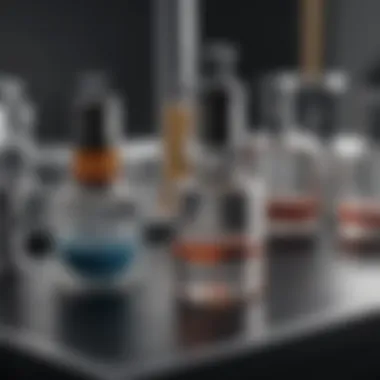Matrigel Assay: Insights into 3D Cellular Behavior


Intro
The matrigel assay has emerged as an essential method in cell biology, enabling researchers to investigate cellular behaviors in a three-dimensional context. This approach mimics the extracellular matrix more closely than traditional two-dimensional cultures, providing a more accurate representation of how cells interact with their environment. Understanding the intricacies of this assay is vital for anyone engaged in biological research or applications related to tissue engineering and regenerative medicine.
In this article, we will explore key concepts related to the matrigel assay, examine current research trends, and delve into the methodologies employed by scientists to utilize this tool effectively. By elucidating these aspects, we aim to offer readers a comprehensive understanding of the matrigel assay and its broad implications in ongoing studies across various fields.
Prolusion to Matrigel Assay
The matrigel assay plays a pivotal role in contemporary biological research. Its importance stems from the ability to mimic the in vivo environment, offering a platform for studying cellular behaviors in a controlled three-dimensional (3D) setting. This is vital because standard two-dimensional cultures fail to replicate the complex interactions and matrix compositions present in living organisms. The matrigel's unique properties allow for a more accurate assessment of cell functions and responses, making it essential for various applications from cancer research to stem cell biology.
Definition and Purpose
Matrigel is a gelatinous protein substance derived from the basement membrane matrix of mouse sarcoma cells. It primarily consists of laminin, collagen IV, entactin, and heparan sulfate proteoglycans. The primary purpose of the matrigel assay is to promote and support the growth and differentiation of cells in a 3D environment, enabling researchers to observe cellular interactions and behaviors that would not be evident in traditional flat cultures.
This assay provides a scaffold that can be modified for specific experiments, allowing for applications such as testing drug efficacy, assessing tumor formation, and studying stem cell differentiation. Its versatility makes it an attractive choice for many different fields within biological sciences.
Historical Development
The development of the matrigel assay emerged from the need for improved cell culture techniques that could better model human physiology. The origins date back to the late 20th century when researchers sought ways to replicate the extracellular matrix conditions found in vivo. Prior to this, cells were mainly cultured on plastic surfaces, which restricted their ability to grow and interact as they would in a natural environment.
The introduction of matrigel provided an innovative solution. By blending various matrix components, it allowed for enhanced cellular activities such as adhesion, proliferation, and differentiation. Its use has expanded significantly since, leading to key breakthroughs in understanding cancer metastasis, stem cell behavior, and tissue engineering. As research progressed, matrigel and its derivatives have become a staple in laboratories worldwide, underpinning an extensive range of scientific studies.
Components of Matrigel
Understanding the components of Matrigel is fundamental to effectively utilizing the matrigel assay. This section provides insights on the intricate composition of Matrigel and explores the various types available. Each element plays a crucial role in how cells interact with their environment, ultimately influencing outcomes in research applications.
Composition Analysis
Matrigel is a gelatinous protein matrix derived from the basement membrane of mouse sarcoma. Its composition can vary, but it typically contains several key proteins, such as collagen IV, laminin, and entactin. These proteins form a specific three-dimensional structure that mimics the natural extracellular matrix (ECM) found in tissues.
The complexity of Matrigel's composition is significant:
- Collagen IV provides structural support and facilitates cell adhesion.
- Laminin promotes cell migration and differentiation.
- Entactin enhances the stability of the matrix.
Understanding this composition helps researchers tailor assays for specific types of cells or experimental conditions. While Matrigel itself is a versatile tool, variations in its preparation and use can lead to inconsistencies, making it crucial to analyze the specific composition for each application.
Types of Matrigel
Various types of Matrigel products are available in the market, each designed to cater to specific experimental needs. These types include:
- Standard Matrigel: The original formulation, suitable for general cell culture applications.
- Matrigel Matrix: Enhanced formulation aimed at improving gelation properties and allowing for better cell growth.
- Growth Factor Reduced Matrigel: Contains fewer growth factors, ideal for researchers wanting to control cellular environments more precisely.
- Membrane Matrix: Specifically developed for studies requiring a scaffold that mimics the fiber arrangement of natural membranes.


Each of these variants offers different benefits, hence choosing the appropriate type is critical for obtaining relevant experimental outcomes. Factors such as the target cell type, the stage of research, and specific assay requirements should guide this selection.
"The choice of Matrigel type can significantly influence the behavior of the cells being studied and, by extension, the conclusions drawn from the assay."
"The choice of Matrigel type can significantly influence the behavior of the cells being studied and, by extension, the conclusions drawn from the assay."
In summary, a thorough comprehension of the components and types of Matrigel empowers researchers. This knowledge not only aids in choosing the right materials but also enhances the quality and reliability of the results obtained from matrigel assays.
Methodology of Matrigel Assay
The methodology surrounding the matrigel assay is crucial. Understanding this topic allows researchers and professionals to grasp the full potential of matrigel in various applications. Each step in the methodology has its significance and can influence the outcomes of experiments. Mastery of these techniques can lead to improved reproducibility and reliability of results.
Preparation of Matrigel
Preparing matrigel is an essential first step. The gel is derived from mouse sarcoma cells, thus providing an extracellular matrix. To prepare it, one must first thaw the matrigel solution at 4°C. Afterwards, gently mix the matrigel to achieve a homogeneous solution. Keep in mind that excessive agitation must be avoided to maintain the integrity of the matrix. Once mixed, one can use it to coat plates or culture vessels. It's vital to pipette the desired amount into the culture dish. The thickness of the layer can also affect cell behavior. A layer thickness of approximately 300-400 µm is generally considered optimal for most applications.
Cell Culture Techniques
Cell culture techniques play a key role in the success of the matrigel assay. The choice of cell line is fundamental depending on the research objective. Adherent cells are typically cultured on matrigel to mimic their natural environment. Before introducing the cell line to matrigel, ensure cells are in a logarithmic growth phase for optimal results. After preparing the matrigel-coated dish, gently add the cell suspension to achieve a desired density. Normal incubatory conditions should be maintained, typically at 37°C with 5% CO₂. Regular checks must be done for confluence and cell morphology. Another important aspect is the medium composition. Choosing the right growth factors can also enhance cellular behavior, important for various assays.
Assay Procedures
The next stage involves conducting the assay procedures. These protocols can vary significantly based on the intended application. Begin by ensuring that necessary controls are in place. For instance, including both experimental and control groups is vital for comparative analysis. One common procedure involves stimulating the culture with specific signals to observe cellular responses. Common readouts may include proliferation rates or migration patterns.
Experimental endpoints should also be predefined. Whether measuring via microscopy, flow cytometry, or gene expression analysis, clear criteria help in achieving reliable data. Statistical analysis follows, calculating significance and validating findings.
In summary, mastering the methodology for conduction of the matrigel assay is indispensable. Each step, from preparation through to application, deeply influences the experimental outcomes. Understanding these processes provides a roadmap for conducting high-quality research.
Applications of Matrigel Assay
The matrigel assay is instrumental in various research areas due to its capacity to mimic physiological conditions within a three-dimensional space. This ability to create a more realistic environment for cell cultures allows scientists to examine cellular behavior in a way that two-dimensional cultures cannot. The applications of matrigel assay span several domains, including cancer research, stem cell research, and drug development. Each of these areas benefits from the enhanced insights offered by matrigel, leading to significative advances in understanding complex biological processes.
In Cancer Research
The application of matrigel assays in cancer research is both extensive and vital. Tumor cells exhibit unique behaviors, such as invasion and metastasis, which cannot be adequately studied in standard two-dimensional cultures. By utilizing matrigel, researchers can observe how cancer cells invade surrounding tissues and interact with various extracellular matrix components. This is crucial for understanding mechanisms of cancer progression and identifying potential therapeutic targets.
Moreover, the matrigel assay can serve as a platform for testing the efficacy of anticancer drugs. It allows for the assessment of drug response in a more biologically relevant context. Changes in cell morphology, viability, and proliferation can be monitored in real time, providing valuable data on the effectiveness of novel drug candidates.
In Stem Cell Research
Matrigel assays play a significant role in stem cell research, particularly in the field of tissue engineering and regeneration. Stem cells require specific microenvironments to maintain pluripotency and guide differentiation. The supportive matrix provided by matrigel recreates a necessary three-dimensional environment that influences stem cell fate. Researchers can study the effects of various growth factors on stem cell behavior and identify optimal conditions for differentiation into specific cell types.
Additionally, matrigel has been instrumental in advancing organoid technology. By allowing stem cells to organize and grow into miniaturized organ-like structures, matrigel proves invaluable in studying organ development, disease models, and drug response at a more complex level.


In Drug Development
The use of matrigel in drug development offers several advantages. Utilizing a three-dimensional culture model significantly enhances the predictive power of preclinical studies. With the ability to simulate tumor microenvironments or organ systems, matrigel assays can provide insights into pharmacodynamics and pharmacokinetics that are closer to in vivo settings.
Furthermore, these assays facilitate the identification of potential side effects and interactions that may arise in a more complex biological landscape. This is particularly important in the screening of new pharmaceuticals, ensuring that candidates that proceed to clinical trials have been thoroughly evaluated in a relevant context.
Advantages of Matrigel Assay
The matrigel assay is highly regarded for its numerous advantages in cell biology research and drug development. Understanding these benefits helps researchers and students appreciate the critical role that matrigel plays in scientific investigation. This section outlines two primary advantages of the matrigel assay: the creation of a three-dimensional environment and enhanced cellular interactions.
Three-Dimensional Environment
One of the most notable strengths of matrigel assay is its ability to provide a three-dimensional environment for cell culture. Traditional two-dimensional cultures offer limited insights into cellular behavior. In contrast, matrigel allows cells to grow in an architecture that closely resembles their natural surroundings. This 3D structure offers several significant benefits:
- Improved Cell Behavior: When cells are cultured in three dimensions, they exhibit behaviors that are more consistent with what is observed in vivo. This leads to more accurate data regarding cell growth, differentiation, and responses to stimuli.
- Tumor Modeling: In cancer research, 3D cultures are essential for studying tumor biology. Matrigel mimics the extracellular matrix, enabling researchers to analyze cancer cell invasion and metastasis in a controlled environment.
- Microenvironment Influence: Cells interact with their microenvironment in complex ways. Matrigel provides a scaffold that can influence gene expression and cellular signaling, aiding in the study of these interactions.
This three-dimensional aspect of the matrigel assay is pivotal for gaining a deeper understanding of cellular dynamics and disease mechanisms.
Enhanced Cellular Interactions
Another significant advantage of the matrigel assay lies in its capacity to enhance cellular interactions. The interactions between cells and their surrounding matrix are critical for various biological processes. Matrigel supports these interactions in several ways:
- Cell-Cell Interactions: In three-dimensional cultures, cells can better interact with one another, forming connections similar to those that occur in actual tissues. This phenomenon helps in studying cell signaling pathways and cell-to-cell communication.
- Extracellular Matrix Mimicry: Matrigel comprises proteins found in the extracellular matrix, which plays an essential role in cell adhesion. By simulating this matrix, matrigel encourages proper cell attachment and facilitates the study of adhesion-related processes.
- Impact on Differentiation: Enhanced interactions also influence cellular fate decisions. Cells in a matrigel environment can differentiate into specific lineages more effectively than in standard culture.
The matrigel assay significantly improves our understanding of cellular behavior by replicating more realistic biological conditions.
The matrigel assay significantly improves our understanding of cellular behavior by replicating more realistic biological conditions.
Limitations and Considerations
Examining the limitations and considerations of the Matrigel assay is crucial for understanding its applications. While this assay is a powerful tool, it is not without challenges. Researchers should be aware of these factors to ensure accurate and reliable outcomes. Critical aspects include variability and reproducibility issues and ethical considerations related to using biological materials.
Variability and Reproducibility Issues
Variability in results is a significant concern when using Matrigel assays. The composition of Matrigel can differ between batches due to production processes. Each lot can have variations in protein concentrations, which may lead to inconsistent cell behavior. This presents a challenge in experiments requiring high reproducibility. To mitigate these issues, researchers should:
- Use commercially available Matrigel from reputable suppliers to minimize variability.
- Conduct preliminary tests to establish the performance of each batch before full-scale experiments.
- Consider using alternative extracellular matrix components that may offer more consistency.
Additionally, the experimental conditions, such as temperature, pH, and even the cell types being cultured, can significantly influence results. Each variable must be carefully controlled to ensure reproducibility. This can be particularly problematic in multi-laboratory studies where consistency across different settings is required. Researchers must document these variables to clarify their impact on the results.
Ethical Considerations
Ethical considerations play a vital role in the use of Matrigel assays, especially regarding its biological origins. Matrigel is derived from mouse sarcoma, raising concerns about animal welfare and the implications of using animal products in research. The sourcing of such materials must be addressed by the scientific community. To navigate this, it is essential to:


- Ensure that the animal tissues used comply with ethical guidelines and regulations.
- Explore alternatives, such as synthetic matrices, which can provide a more ethical option without compromising experimental quality.
- Be transparent when publishing results, especially those involving animal-derived materials. Researchers should highlight the sources of their Matrigel and justify its use based on research needs.
These ethical considerations not only affect the reliability of the assay but also impact public perception of scientific research. As research continues to evolve, finding ways to balance the benefits of such assays with ethical standards will be crucial.
"Understanding the limitations and considerations of the Matrigel assay is essential for its effective and ethical use in research."
"Understanding the limitations and considerations of the Matrigel assay is essential for its effective and ethical use in research."
Future Directions of Matrigel Assay
As the matrigel assay continues to evolve, it is imperative to consider the future directions of its application. The advancements in this field are essential, especially as they pave the way for new research methodologies and therapeutic approaches. Understanding these future directions can impact how researchers and practitioners approach cellular studies and treatments. The integration of advanced technologies and the potential for personalized medicine are two critical areas that deserve attention.
Integration with Emerging Technologies
Integrating emerging technologies into the matrigel assay can enhance its effectiveness and broaden its applications. Innovations in imaging techniques, such as live-cell imaging and high-throughput screening, are enabling researchers to observe cellular behaviors in real-time within the matrigel matrix. This evolution allows for a more dynamic understanding of cellular processes, such as migration, interaction, and drug responses.
Moreover, the incorporation of microfluidic devices with matrigel will facilitate precise control over the culture environment. Researchers will be able to manipulate fluid flow and recreate physiological conditions more accurately. This advancement can lead to more reliable data, ultimately driving better experimental outcomes. The synergy between these technologies and the matrigel assay represents a significant leap forward for cellular research.
"Emerging technologies combined with matrigel can enhance our understanding of complex cellular behaviors."
"Emerging technologies combined with matrigel can enhance our understanding of complex cellular behaviors."
Integrating artificial intelligence also presents opportunities for analyzing complex datasets generated from matrigel assays. AI algorithms can analyze subtle changes in cellular behavior that may be overlooked by traditional methods, offering deeper insights into cellular interactions and responses.
Potential in Personalized Medicine
The future of the matrigel assay includes a substantial role in personalized medicine. As researchers aim to tailor treatments to individual patients, the ability to study patient-derived cells in a 3D context becomes invaluable. The matrigel assay allows for the cultivation of cells from specific patients, including cancer or stem cells, in a controlled environment that mimics in vivo conditions. This modeling can provide critical information on how a patient's cells respond to various treatments, thereby improving therapeutic strategies.
Furthermore, advancements in genomics and proteomics can be incorporated into matrigel assays, allowing for a more comprehensive evaluation of patient-specific therapies. By studying how unique genetic expressions affect cellular behavior in a 3D environment, researchers can develop more effective, targeted interventions.
Finale
The conclusion plays a vital role in the context of the matrigel assay. It encapsulates the major findings and insights presented throughout the article, allowing readers to grasp the significance of the content discussed. Highlighting the overarching themes, this section reiterates the importance of the matrigel assay in contemporary biological research.
Summary of Key Insights
The matrigel assay has cemented itself as a pivotal tool in biological studies. Its utility across various disciplines such as cancer research, stem cell research, and drug development cannot be overstated.
- Three-Dimensional Cell Culture: The assay provides a more physiologically relevant environment compared to traditional two-dimensional cultures.
- Enhanced Cell Interactions: Researchers have observed that cellular behaviors, including growth and differentiation, are more accurately represented in a three-dimensional matrix.
- Applications in Drug Testing: The assay facilitates the evaluation of therapeutic compounds in a setting that closely mimics in vivo conditions.
Through these points, it is clear that the matrigel assay's capabilities extend beyond mere cell growth. It shapes our understanding of cell biology and informs potential clinical applications.
The Importance of Continued Research
Ongoing investigation into the matrigel assay is essential for several reasons. Advancements in technology and methodology can lead to improved assay designs, which may enhance reproducibility and reliability.
Furthermore, integrating matrigel with new scientific paradigms, such as personalized medicine, can unlock further potential in tailored therapies. Continued research can also address inherent limitations, such as variability in source materials and ethical considerations surrounding its use. By prioritizing these areas, researchers can maximize the impact of the matrigel assay in both fundamental science and clinical applications.
In summary, this concluding section emphasizes the matrigel assay's importance not just in evaluating cellular behavior but also as a foundational tool for future innovations in biological research.







